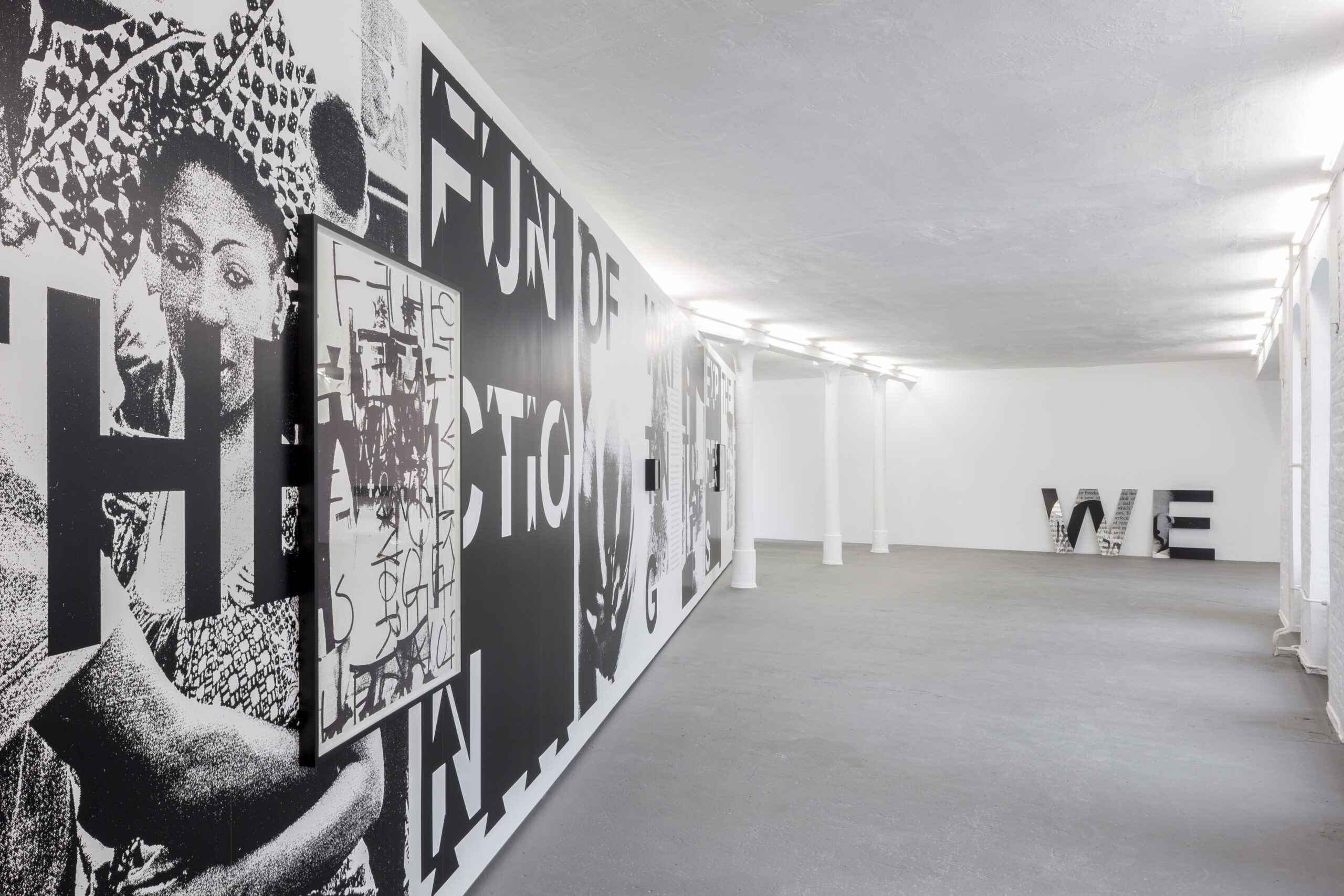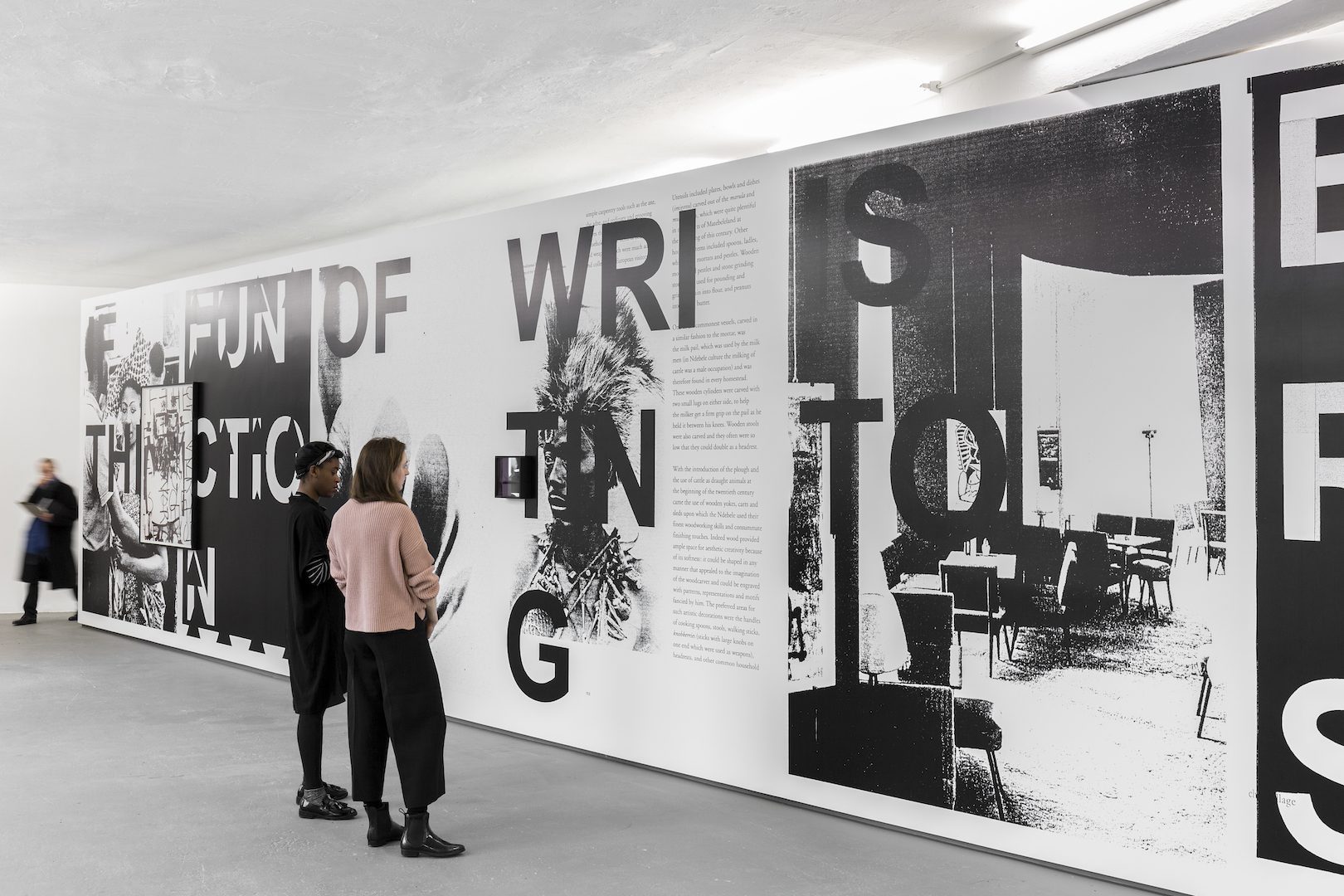Notre auteur Gauthier Lesturgie a rencontré l'artiste Adam Pendleton au sujet de son expo shot him in the face qui est actuellement en vue au KW Institute for Contemporary Art à Berlin

Adam Pendleton, shot him in the face. Installation view. KW Institute for Contemporary Art, 2017. Photo: Frank Sperling
Gauthier Lesturgie : Si la fonction de l’écriture est d’« exprimer le monde » et Tire-lui en plein visage (shot him in the face) – le point de départ et le titre de ton exposition sont tous les deux des citations du poème Albany, écrit par Ron Silliman. Ron Silliman a théorisé son système d’écriture dans son essai The New Sentence qui propose une prose sur le modèle du collage, faite de phrases courtes et juxtaposées. Je trouve que cette méthode de montage est très proche de ta manière de créer : ton langage est fait d’ellipses, d’assemblages et de juxtapositions. Pourrais-tu nous en dire plus sur ton intérêt pour Ron Silliman ?
Adam Pendleton : Je m’intéresse de manière générale aux théories du langage, en particulier à la manière dont elles coexistent avec des traditions poétiques spécifiques. L’idée de Ron Silliman dans The New Sentence s’est finalement retrouvée dans mon travail et je l’ai appliquée à un dispositif visuel : coller, superposer des phrases, mais pas pour créer un travail fixe et définitif. Cela peut sembler vaste et abstrait, mais tu essayes vraiment de structurer des significations, et de créer de nouvelles logiques, de nouvelles formes de narrations qui perturbent le sens linéaire de la narration pour proposer quelque chose d’autre. Il y a une dimension critique qui est en jeu, en relation avec la phrase, l’image, le mot lui-même et c’est justement ce qui est examiné et mis en œuvre. Cette exposition rassemble beaucoup d’idées et d’ensembles de travaux sur lesquels j’ai travaillé pendant très longtemps, et que j’ai retravaillés et réorganisés en différentes phrases et différentes images.
Albany fait partie d’un ensemble plus large de Silliman appelé Ketjack, c’est en quelque sorte le travail de toute une vie, une œuvre absolument considérable. Comme tant d’autres de ses écrits, la phrase, l’idée même de celle-ci, est absolument généreuse ; cette chose, cette structure simple va dans tellement de directions en même temps et c’est ce que j’attends d’un objet artistique. Que par le biais d’une construction stylisée, nous puissions, en tant que spectateurs, aller dans plusieurs directions à la fois.

Adam Pendleton, WE (we are not successive), 2015, face. Installation view. KW Institute for Contemporary Art, 2017, Courtesy of the artist and Pace Gallery, New York. Photo: Frank Sperling
GL : shot him in the face fait partie de la série du KW consacrée à l’artiste Ian Wilson : elle rassemble les œuvres de Wilson, avec celles d’autres artistes contemporains, et elle présente aussi sa pratique comme cadre conceptuel. Certaines connexions entre ton travail et le sien se font rapidement, notamment la réflexion menée sur les formes discursives et leur usage. Moins évident, peut-être, est le profond intérêt pour l’abstraction que tu partages avec Ian Wilson. Peux-tu nous en dire plus sur cette cohabitation ?
AP: Ian Wilson est un artiste conceptuel très important qui a souvent exploré la matérialité du langage, ou dans ce cas précis son absence. Ses discussions sont devenues des œuvres importantes qu’il « fait » avec son public, elles se produisent et c’est tout. Il est intéressant de voir, dans cette exposition, deux artistes intéressés par le langage – et dans mon cas, par le langage comme image et l’image comme langage. Nous terminons par un dialogue entre deux toiles monochromatiques. La sienne est un rectangle légèrement décentré, la mienne est un monochrome noir qui détourne l’espace de la peinture moderne, noire et monochromatique, comme le Carré noir sur fond blanc de Malevitch. Ces deux façons de faire peuvent modifier l’espace. Ce n’est pas de la peinture à la main, c’est un peu mécanique, le panneau est reproductible mais il conserve l’intimité de quelque chose qui serait fabriqué à la main, avec une application dans le détail : la nuance de noir, la finition, le diptyque – ce sont deux éléments qui vont de pair pour n’en former qu’un – et la lettre « a » placée sur le côté vient du mot « Black Dada ». Il y a une sorte de processus de libération et d’abstraction en relation avec la peinture, mais aussi en relation avec la langage et l’histoire et la manière dont l’abstraction peut signifier la liberté. Ces toiles se parlent, c’est un dialogue, c’est un mécanisme d’échange. Je trouve cela à la fois inattendu et productif.
C’était surtout une idée de Krist Gruijthuijsen, le commissaire de l’exposition, et j’étais vraiment convaincu lorsque nous avons travaillé sur cette exposition que cela ne fonctionnerait pas. J’avais en tête une sorte de disposition et de plan précis que Krist et moi avions développé durant nos discussions intenses, ce mur qui diviserait l’espace en deux, et ce qui serait accroché dessus, quelle phrase, etc. Mais je pensais que l’emplacement du travail d’Ian Wilson viendrait perturber les choses d’un point de vue formel. Et puis, lorsque la toile a été accrochée, ce rectangle monochrome rouge légèrement décalé, est devenu une sorte de filtre pour ma propre peinture. Pour moi, la « peinture Black Dada » est une sorte d’étape où mes théories sur le langage, l’histoire et l’abstraction se jouent sur cette scène, sur ce fond. Cette rencontre a ouvert un espace. Je pense que cela a débouché sur quelque chose de nouveau, en relation avec l’art conceptuel, et avec les mots écrits et parlés.

Adam Pendleton, shot him in the face. Installation view. KW Institute for Contemporary Art, 2017. Photo: Frank Sperling
GL : J’aimerais qu’on parle de la réalisation de l’espace lui-même. J’aime bien cette idée d’archive comme lieu d’où proviennent les sources, et on peut dire que c’est très présent dans ton travail : tu produis tes archives dans ton atelier et, après diverses manipulations (photocopie, sérigraphie, recadrage, etc.), tu les réutilises pour créer un espace très physique. Tes archives deviennent alors plus tangibles que figuratives : pour cette exposition, tu as construit un grand mur, c’est peut-être l’élément le plus élémentaire quand il est question d’espace.
AP : D’un point de vue pratique, le mur représente une solution spatiale qui a fini par influencer l’accrochage et la façon dont fonctionne mes travaux dans l’espace. Il coupe véritablement la galerie en deux et devient une sorte de surface uniforme où se retrouvent des images et des références différentes : du couple qui danse le jour de l’Indépendance du Congo en 1960 à la photographie d’une fleur prise par un étudiant du Bauhaus, en passant par des extraits de la toute première Documenta et des échantillons de tissus. Tous ces travaux ont recours au langage avec un degré différent d’abstraction. Je pense que la perturbation architecturale interroge la lisibilité en termes d’espaces, mais aussi la façon dont nous percevons et traversons cet espace où plusieurs gestes se croisent, de manière à la fois grave et ludique.

Adam Pendleton, Black Dada/Column (A), 2015. Courtesy of the artist and Galerie Eva Presenhuber, Zurich;
Ian Wilson, Red Rectangle, 1966 (reconstructed in 2008). Courtesy of the artist and Jan Mot, Brussels. Installation view. KW Institute for Contemporary Art, 2017. Photo: Frank Sperling
GL : J’ai lu que tu allais publier au cours de l’exposition ton recueil de textes « Black Dada ». Peux-tu nous en dire plus au sujet de cette publication à venir ?
AP : L’idée est de publier le Black Dada Reader au cours de l’exposition et de réaliser le lancement du livre à Berlin. Le livre fait à peu près 300 ou 400 pages et, au départ, c’était juste une publication de l’atelier qui mettait en avant cette idée de Black Dada. Désormais, le livre contient des essais qui font référence à des gens comme Hugo Ball, W.E.B. Du Bois, Stokely Carmichael et Gertrude Stein, ainsi qu’à des artistes de différentes générations, comme Joan Jonas et William Pope.L, et ces essais ont été rédigés par des commissaires d’exposition et des historiennes de l’art comme Adrienne Edwards, Jenny Schlenzka, Laura Hoptman, Tom McDonough et Susan Thompson. Cette publication mettra en avant un processus de traduction qui, je l’espère, dévoilera tout son potentiel et sa générosité.
Gauthier Lesturgie est un auteur et traducteur (de l’anglais au français) indépendant basé à Berlin. Depuis 2010, il a travaillé avec différentes structures artistiques telles que Den Frie Centre for Contemporary Art (Copenhague), la revue Critique d’art, les 2e et 3e Biennales d’art contemporain de Rennes ou encore SAVVY Contemporary (Berlin). Il écrit aujourd’hui pour divers supports comme 02 (Nantes), Contemporary And (Berlin), Espace art actuel (Montréal), ETC media (Montréal), Inter art actuel (Québec), Momus (Toronto), Mouvement (Paris) ou encore Sleek (Berlin).
More Editorial